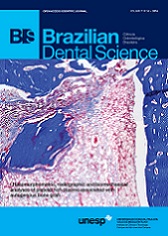A comparative study of the conventional and digital intraoral radiography methods for root canal length measurement
DOI:
https://doi.org/10.14295/bds.2014.v17i4.997Resumo
Objective: Measurement of root canal length is one of the most important stages of endodentic treatment, and any error at this stage can lead to the failure. This study aimed to compare conventional and digital intraoral radiography in measurement of root canal length. Material and Methods: In this study, 35 single-canal maxillary teeth were collected. Access cavities were prepared. An endodontic number 10#K- file was introduced into the canal, until the tip was visible at the apical foramen and the actual canal length (gold standard) was determined. After acquisition conventional radiographs using E-Ektaspeed and F-Insight film (Eastman-Kodak Co. Rochester, NY, USA) and digital radiographs using Photostimulable Phosphor Plates(PSP) (Soredex, Helsinki, Finland) and Charge Coupled Devices (CCD)(RVG, Trophy,NY,USA). they were examined separately with a two-week interval by two oral and maxillofacial radiologists. The data were analyzed with ANOVA and Tukey’s tests using SPSS-19 software (SPSS Inc., Chicago, IL, USA). Result: No statistically significant difference was observed between different radiographies, and different observers (P > 0.05). Nevertheless, in comparison with the gold standard, in all cases, the F-speed conventional radiography and the digital CCD radiography showed the highest and the lowest accuracy, respectively. Also, the PSP and the E-speed conventional radiography were in the second and third order of accuracy, respectively. Conclusion: The use of digital radiography does not improve the accuracy of the root canal length measurement,but the digital technique has advantages,such as the reduced patient exposure ,eliminating the time consuming processing stages, and producing fast images.
Downloads
Downloads
Arquivos adicionais
Publicado
Como Citar
Edição
Seção
Licença
TRANSFERÊNCIA DE DIREITOS AUTORAIS E DECLARAÇÃO DE RESPONSABILIDADE
Toda a propriedade de direitos autorais do artigo "____________________________________________________________________" é transferido do autor(es) para a CIÊNCIA ODONTOLÓGICA BRASILEIRA, no caso do trabalho ser publicado. O artigo não foi publicado em outro lugar e não foi submetido simultaneamente para publicação em outra revista.
Vimos por meio deste, atestar que trabalho é original e não apresenta dados manipulados, fraude ou plágio. Fizemos contribuição científica significativa para o estudo e estamos cientes dos dados apresentados e de acordo com a versão final do artigo. Assumimos total responsabilidade pelos aspectos éticos do estudo.
Este texto deve ser impresso e assinado por todos os autores. A versão digitalizada deverá ser apresentada como arquivo suplementar durante o processo de submissão.




























